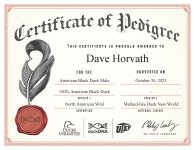I hate to admit it but hunters in my own state has been releasing mallards for years. Alabama Waterfowl Association (AWA) has released tens of thousands of mallards for more than 35 years. Jerry Davis started this program and has defended it for many years in the face of criticism from hunters. The ducks, known as "Jerry's Kids" by hunters that dislike the practice, are banded and released primarily in north Alabama. I just checked and they are banding 1,300 farm raised mallards today for release. The below links provide more info. Of particular interest to me is the "study" of their release program they did. Not exactly the type of research that would make it in The Journal of Wildlife Management. Their argument for the program can be summed up by a quote from their research paper. "AWA’s mallard project and other state mallard projects data has shown that the released ducks that do go back north have shown evidence that they bring other migrating mallards to traditional southern over-wintering grounds." They contend the released mallard recruit wild mallards to our area. Many of these ducks are shot on the duck clubs where they are released as a substitute for wild ducks.
For your reading pleasure...

 www.facebook.com
www.facebook.com
For your reading pleasure...
AWA Alabama Waterfowl Association
a source for any waterfowler, duck hunting, wetland banking, goose hunting, waterfowl hunting, hunting, ducks, geese, waterfowling, wetland migration,
www.alabamawaterfowl.org

Alabama Waterfowl Association | Scottsboro AL
Alabama Waterfowl Association, Scottsboro. 2,709 likes · 3 talking about this. A STATE VOICE FOR ALABAMA WATERFOWL HUNTERS, CONCERNING THE WATERFOWL HUNTING SEASON AND THE FEDERAL MIGRATORY BIRD...
 www.facebook.com
www.facebook.com
AWA Alabama Waterfowl Association
a source for any waterfowler, duck hunting, wetland banking, goose hunting, waterfowl hunting, hunting, ducks, geese, waterfowling, wetland migration,
www.alabamawaterfowl.org


